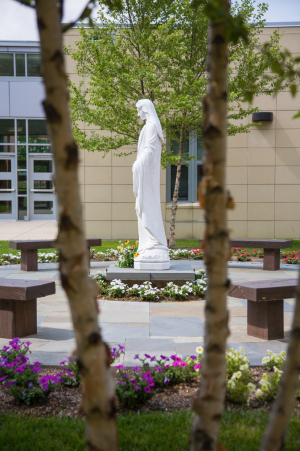- © 2025 Annapolis Home Magazine
- All Rights Reserved

Rosary, from the Latin rosarium, means “garden of roses.” According to legend, in an apparition, Mary, the Mother of Jesus, said that each bead on the rosary is a rose, and, when someone completes a rosary, they are giving her a crown of roses.
The rosary is used to recite many prayers, including the powerful Catholic prayer, the Hail Mary. Through this prayer, one may ask the Blessed Mother to speak directly to Jesus for them. It is believed that because he cannot refuse his Mother, the request may be granted.
The physical rosary is also an object, a nonverbal narrative that begins with the cross Jesus was crucified upon. And, that is how this garden begins, with a cross made of light Travertine marble, which is the same material used to build the Basilica in Rome, explains Steve McHale, owner of McHale Landscape Company. This garden is composed not just in the form of a rosary, it is a rosary, one that you may walk with your feet or travel with your eyes. Instead of beads, there is a circle of carved flagstones, with Mary herself in the center.
McHale conceived and created the garden last year as a gift to his sons’ school, Archbishop Spalding High School, where it is used by students, bereavement groups, and anyone seeking quiet time to reflect. Archbishop Spalding president Kathleen K. Mahar commends McHale and the many donors involved in the ambitious project, which was blessed last September by Archbishop of Baltimore William E. Lori.
 This garden is unusual in that it is propelled by the rhythms of prayer and experienced by the rhythms of walking. As one walks the rosary, one follows Mary’s journey: the birth, life, death, and resurrection of her son. These words also define a garden’s seasons and our own: there is life, new growth, blossomings, and endings. Like the rosary, this garden’s simplicity contains greater depths. When one says a formal rosary, one meditates on the four sacred mysteries: Joyful, Sorrowful, Glorious, and Luminous. The garden is planted in quadrants named for each mystery; plantings complement each mystery’s symbolic color.
This garden is unusual in that it is propelled by the rhythms of prayer and experienced by the rhythms of walking. As one walks the rosary, one follows Mary’s journey: the birth, life, death, and resurrection of her son. These words also define a garden’s seasons and our own: there is life, new growth, blossomings, and endings. Like the rosary, this garden’s simplicity contains greater depths. When one says a formal rosary, one meditates on the four sacred mysteries: Joyful, Sorrowful, Glorious, and Luminous. The garden is planted in quadrants named for each mystery; plantings complement each mystery’s symbolic color.
McHale composed this intimate garden with great attention to detail. The Pietà, the Blessed Mother, and Mother Seaton, an educator and first Saint from America and Maryland, are statuary referencing Catholic history. The Pietà is especially important and meant to lend strength to those in mourning: it is near a memorial wall engraved with the names of students and alumni who have passed. There is a chapel made from rough-cut lumber for small gatherings to meditate or celebrate Mass. The altar is fashioned from a huge slab of stone. McHale notes that creating in a small space can actually be a very good thing. “It is not too big, can’t get too busy. I have to keep it simple, and good design is simple.”
McHale used strong materials on a large scale—rock, marble, wood, and stone—to drive the design. He explains that the landscape should support and complement and is intentionally quiet. “There are only five types of plantings but about three hundred of them,” he says. “I am using them to create a sense of mass; the idea is to compliment not to compete, there’s enough going on between the statues, and that’s where the focus needs to be—with the altar and chapel.”
 It takes an artistic sensibility, discipline, and confidence to keep things minimal. This simplicity is appropriate, as Jesus was, after all, the son of a carpenter, born in a barn. This garden has to be experienced physically to fully appreciate it. The enduring marble, which will whiten with age, the polished Travertine, rough stone, and plain unadorned wood encourage a kind of receptivity. There is enough solid matter to provide shelter and encourage intimacy yet plenty of free space, which a spirit must have to approach you, should you feel the need to connect and request assistance.
It takes an artistic sensibility, discipline, and confidence to keep things minimal. This simplicity is appropriate, as Jesus was, after all, the son of a carpenter, born in a barn. This garden has to be experienced physically to fully appreciate it. The enduring marble, which will whiten with age, the polished Travertine, rough stone, and plain unadorned wood encourage a kind of receptivity. There is enough solid matter to provide shelter and encourage intimacy yet plenty of free space, which a spirit must have to approach you, should you feel the need to connect and request assistance.
Visitors are welcome to visit the Mary Garden, though permission is required. For more information, go to www.archbishopspalding.org. Summer office hours are from 9 a.m. to 3 p.m. Offices are closed on Friday.
From Vol. 5, No. 4 2014
Annapolis Home Magazine